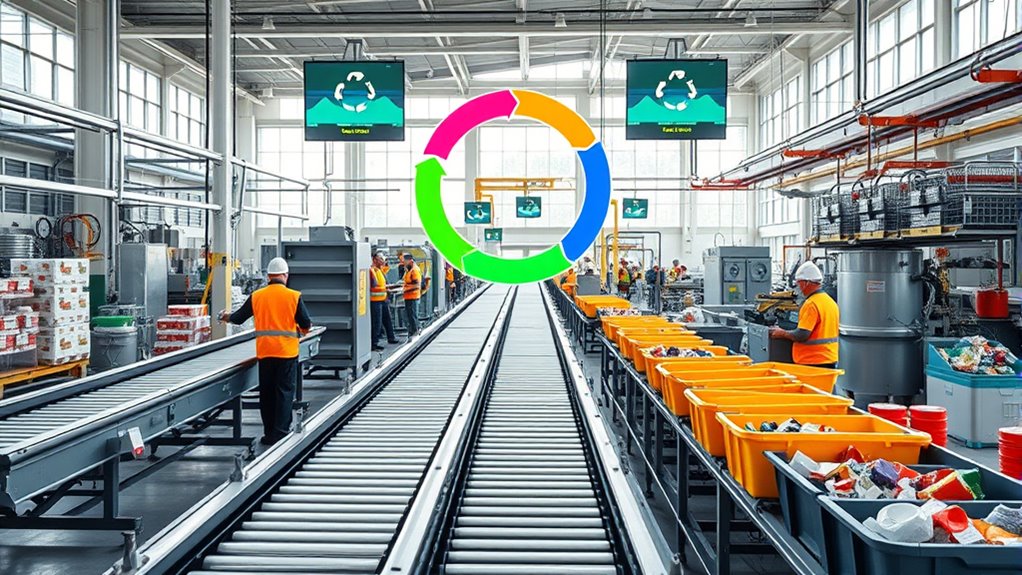The circular economy shifts you from a traditional linear model—extracting resources, using products, and disposing of waste—into a sustainable, closed-loop system. It emphasizes designing products for reuse, repair, and recycling, helping reduce waste and conserve resources. This approach benefits the environment and your bottom line by promoting resource efficiency and innovation. Keep exploring to discover how this shift can revolutionize industries and build a more resilient future.
Key Takeaways
- The linear economy follows a take-make-dispose model, causing environmental harm and resource depletion.
- The circular economy creates a closed-loop system emphasizing reuse, recycling, and sustainable product design.
- Transitioning involves designing products for longevity, repair, and disassembly to extend lifecycles.
- Implementing circular practices reduces waste, conserves resources, and promotes economic resilience.
- Digital technologies enable tracking, transparency, and efficient resource management within circular systems.
Understanding the Linear Economy Model

Have you ever wondered how most products are made and disposed of? In a linear economy, the product lifecycle follows a straightforward path: extract resources, produce goods, use them, and then dispose of the waste. This model prioritizes a waste hierarchy that emphasizes disposal over reuse or recycling, often leading to significant environmental harm. Products are designed with a limited lifespan, and once they’re no longer useful, they’re discarded, creating a cycle of constant resource extraction and waste generation. This approach ignores the potential to extend a product’s life or recover materials. Understanding this linear process highlights why shifting towards sustainable practices—like those promoted in a circular economy—is essential for reducing waste and conserving resources. Resource management can help break this cycle and promote resource efficiency. Moreover, addressing the inefficiencies in resource use can lead to economic benefits by reducing costs and creating new opportunities for innovation. Recognizing the importance of material recovery is vital for transforming waste into valuable resources and fostering sustainable development. Additionally, integrating recycling technologies can further optimize material reuse within the circular framework.
Key Principles of the Circular Economy
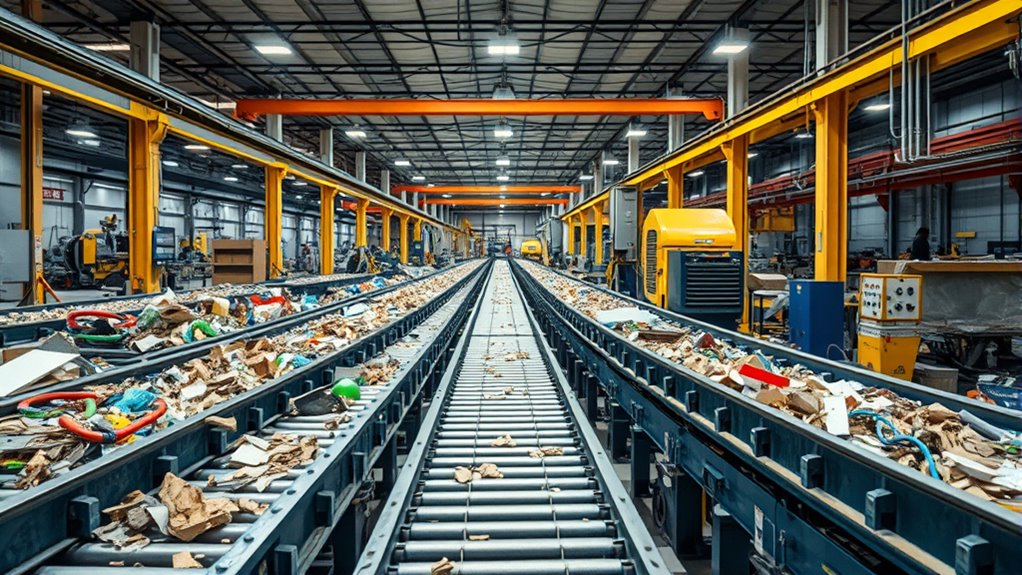
The key principles of the circular economy focus on creating a closed-loop system where resources are kept in use for as long as possible. You achieve this through sustainable design, which emphasizes designing products with their entire lifecycle in mind. This approach ensures products can be reused, repaired, or recycled instead of discarded. Extending the product lifecycle reduces waste and minimizes resource extraction. You also prioritize keeping materials within the economy, avoiding the linear model’s wastefulness. Emphasizing durability and modularity allows products to serve longer and adapt to changing needs. These principles work together to shift from a take-make-waste approach to one that values regeneration, reuse, and responsible resource management. Incorporating mindful decluttering strategies helps maintain organized systems that support sustainability efforts. Additionally, designing for disassembly and recyclability is crucial to ensure materials can be efficiently recovered and reintegrated into the supply chain. Recognizing the importance of recycled materials in manufacturing processes can significantly lower the demand for virgin resources. Implementing effective resource recovery methods further enhances circularity and reduces environmental impact. This transformation is fundamental to building a sustainable, resilient circular economy.
Benefits of Transitioning to a Circular System
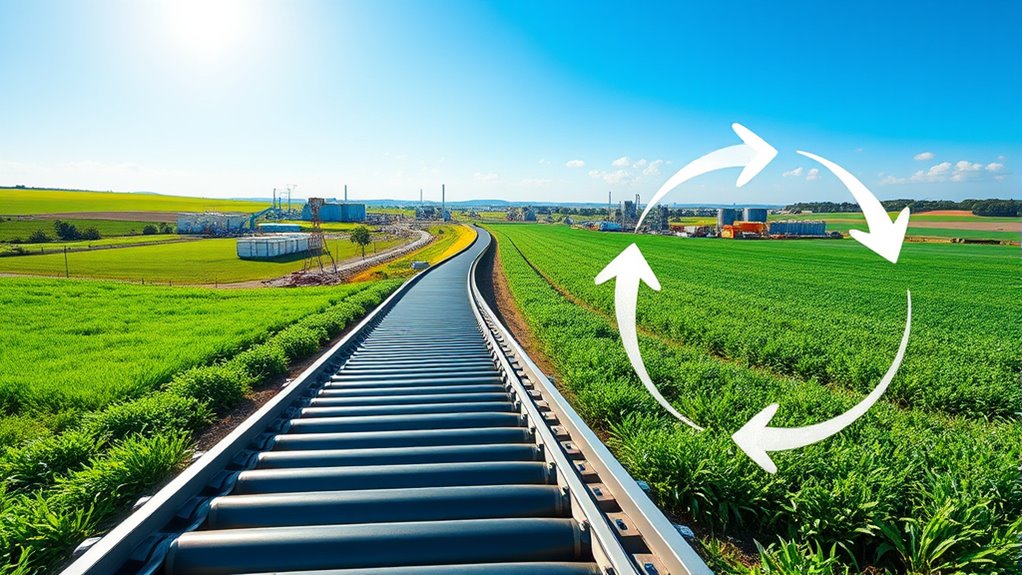
By shifting to a circular system, you can markedly lower environmental impacts and reduce waste. It also helps you make better use of resources, saving money and decreasing dependency on raw materials. Plus, this transition opens up new economic growth opportunities that benefit both your business and the community. Incorporating wall organization systems and aesthetic solutions in your space can further support sustainable practices by promoting efficiency and reducing clutter. Implementing resource management strategies can optimize material use and enhance overall sustainability efforts.
Environmental Impact Reduction
Switching to a circular economy substantially reduces environmental impacts by minimizing waste and conserving resources. You’ll benefit from advancements in recycling innovation and improved waste management practices that keep materials in use longer. This approach encourages sustainable production and helps to lower greenhouse gas emissions, reduce pollution, and lessen the demand for virgin raw materials. By rethinking how products are designed and reused, you cut down on landfill overflow and resource depletion. Additionally, a circular system promotes sustainable production and consumption habits that protect ecosystems. You’ll see a positive ripple effect, with less energy consumption and fewer harmful emissions. Embracing this shift not only preserves natural environments but also fosters innovative solutions that support long-term ecological health. Furthermore, adopting resource-efficient practices can accelerate the transition and maximize environmental benefits. Incorporating regenerative design principles can further enhance resource recovery and ecological resilience. Integrating closed-loop systems into manufacturing processes ensures continuous material reuse, boosting sustainability. A focus on life cycle thinking helps to optimize resource use and minimize environmental footprint throughout a product’s lifespan. Overall, the move to a circular economy greatly benefits the planet’s well-being.
Resource Efficiency Gains
Have you ever considered how a circular economy boosts resource efficiency? By extending the product lifecycle and embracing material innovation, you reduce waste and maximize resource use. When products are designed for reuse, repair, or recycling, you minimize the need for new raw materials, conserving resources. This shift leads to smarter resource management and less environmental strain.
| Benefit | Explanation |
|---|---|
| Extended product life | Products are reused, repaired, or upgraded longer. |
| Reduced raw material use | Fewer new materials are needed for manufacturing. |
| Lower waste generation | Less discard leads to less landfill contribution. |
| Innovation in materials | New materials enable better reuse and durability. |
| Increased efficiency | Resources are used more effectively across the lifecycle. |
Economic Growth Opportunities
Adopting a circular economy opens up significant opportunities for economic growth. Moving to closed-loop systems can stimulate innovation, create new markets, and boost job creation. You can leverage innovative financing models to fund sustainable projects and attract investments focused on circular solutions. As consumer behavior shifts towards eco-friendly choices, businesses that adapt will gain competitive advantages. Embracing circular principles encourages resource sharing, product longevity, and waste reduction, all of which contribute to a resilient economy. This shift not only reduces costs but also open up new revenue streams. By fostering collaboration across industries, you can accelerate growth and sustainability simultaneously. Emphasizing waste reduction and resource efficiency is fundamental to realizing the full benefits of a circular system. Incorporating recycling techniques can further optimize resource use and minimize environmental impact. Additionally, implementing energy-efficient systems like heat pumps can enhance overall sustainability and cost savings. Leveraging digital technologies is crucial for tracking resource flows and ensuring transparency within circular supply chains. Furthermore, understanding the role of cybersecurity in protecting digital assets becomes increasingly important as businesses adopt digital solutions in the circular economy. Ultimately, shifting to a circular system positions you to capitalize on emerging trends, ensuring long-term economic resilience and prosperity.
Strategies for Implementing Circular Practices
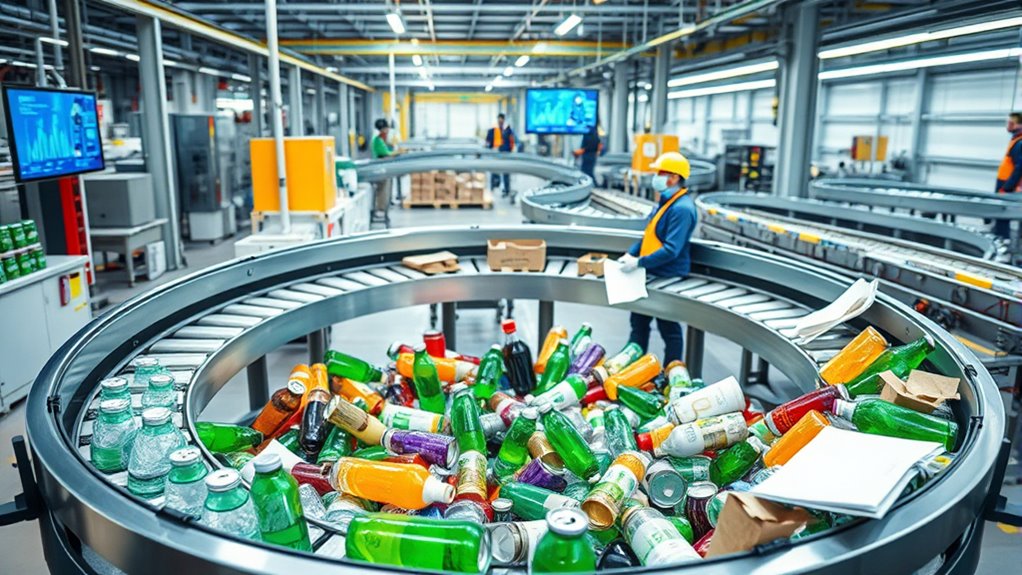
Implementing circular practices requires a strategic approach that integrates sustainability into every aspect of your operations. Start by analyzing the product lifecycle to identify points where waste can be minimized, reused, or recycled. Engage stakeholders early, including suppliers, customers, and partners, to build a shared vision for circularity. Collaboration ensures that sustainability goals align with business objectives and encourages innovative solutions. Develop clear policies and processes that support product design for longevity and recyclability. Invest in training your team to adopt circular principles and foster a culture of continuous improvement. Regularly assess your progress, adjusting strategies based on feedback and evolving best practices. Emphasizing stakeholder engagement and lifecycle management positions you for successful, scalable circular economy adoption. Incorporating data-driven marketing strategies can also enhance your ability to measure and optimize circular initiatives effectively. Additionally, understanding material flow is essential for creating effective closed‑loop systems that maximize resource efficiency. Maintaining transparency through affiliate disclosures can build trust with stakeholders as you implement sustainable practices.
Examples of Circular Economy in Action
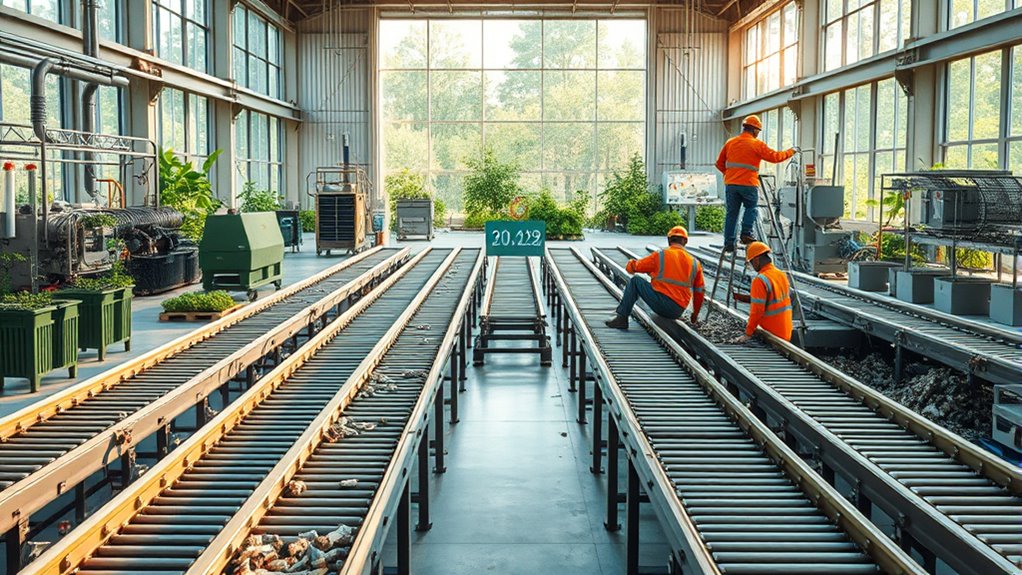
Curious about how companies put circular economy principles into practice? You’ll find that many adopt reuse initiatives to extend product lifecycles and minimize waste. For example, clothing brands now offer take-back programs, refurbishing and reselling garments. Electronics companies develop repair and upgrade services, keeping devices in use longer. Some manufacturers design products for disassembly, making reuse and recycling easier. Additionally, businesses partner with recycling firms to turn waste into new materials, closing the product lifecycle loop. These examples demonstrate practical ways organizations embed circular principles into daily operations, reducing environmental impact and creating value. By focusing on reuse initiatives, they showcase how a shift from linear to closed-loop systems benefits both the planet and their bottom line.
Challenges and Opportunities Ahead
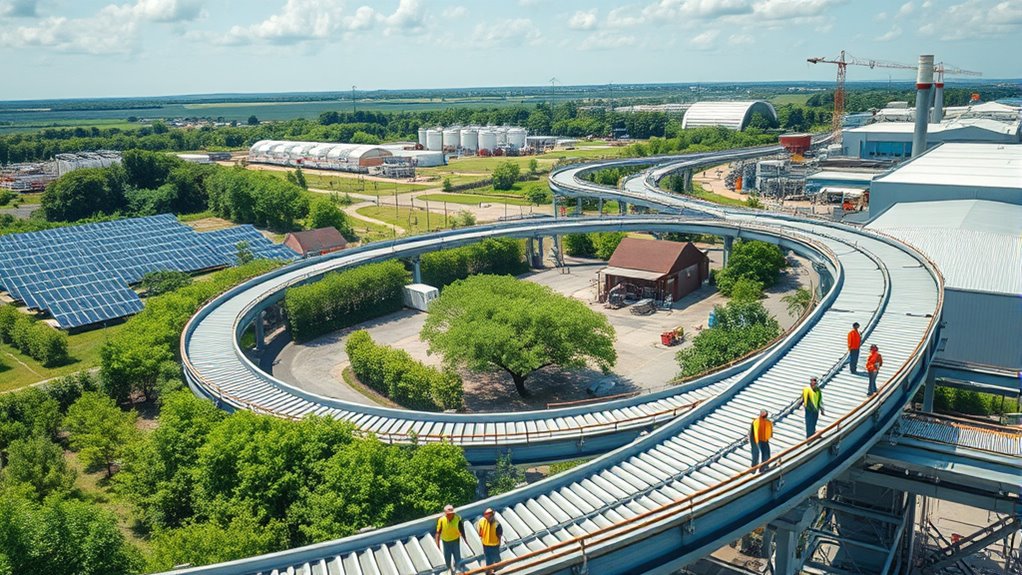
While the shift toward a circular economy offers significant environmental and economic benefits, it also presents notable challenges. One major hurdle is transforming supply chains to prioritize reuse, recycling, and durability, which requires coordination across multiple stakeholders. You’ll need to redesign logistics, sourcing, and manufacturing processes, often incurring initial costs and complexities. Additionally, changing consumer behavior is vital; people must embrace product longevity, repair, and recycling instead of disposable consumption. Overcoming habits rooted in convenience and price can be tough, but education and awareness can drive demand for sustainable products. Opportunities lie in leveraging technological innovations and fostering collaboration among businesses, governments, and consumers. By addressing these challenges, you can help *liberate* the full potential of a circular economy and create more sustainable, resilient systems.
Frequently Asked Questions
How Do Circular Economies Impact Global Supply Chains?
You see, circular economies substantially impact global supply chains by boosting resource efficiency and reducing waste. They encourage you to design processes that reuse materials, cutting down on raw material consumption and waste disposal costs. This shift fosters sustainable practices, making your supply chain more resilient and eco-friendly. Ultimately, adopting circular principles helps you minimize environmental impact while improving overall efficiency and competitiveness in a global market.
What Role Do Consumers Play in Circular Economy Practices?
You hold the key to making circular economy practices thrive. By staying aware of sustainable choices, you can influence companies and encourage recycling initiatives. Your actions, like reusing, repairing, and properly disposing of products, help close the loop. Remember, every small step counts, and when you act consciously, you’re helping shift from wasteful linear models to more sustainable, circular systems that benefit everyone.
How Can Small Businesses Adopt Circular Principles Effectively?
You can adopt circular principles effectively by implementing recycling strategies that minimize waste and maximize resource efficiency. Start by evaluating your supply chain to identify areas for reducing material use and reusing products. Engage your customers in sustainable practices, like encouraging recycling or offering product take-back programs. By continuously improving your resource management, you’ll enhance sustainability, reduce costs, and support a circular economy in your small business.
What Financing Options Support Circular Economy Initiatives?
You can explore various financing options to support your circular economy initiatives. Green bonds are a great way to raise funds specifically for sustainable projects, while public funding offers grants and subsidies that encourage eco-friendly practices. By leveraging these options, you can invest in circular systems, reduce waste, and boost your business’s sustainability efforts more effectively. These financial tools make it easier to shift from linear to closed-loop systems.
How Does Technology Facilitate the Transition to a Circular System?
You might think technology’s role in sustainability is small, but it actually drives huge change. Digital tracking allows you to monitor resources in real-time, reducing waste and boosting efficiency. Material innovation enables you to develop sustainable alternatives, transforming how products are made and reused. By embracing these tools, you actively support the shift toward a circular system, proving that technology isn’t just an aid—it’s a catalyst for a more sustainable future.
Conclusion
Switching from a linear to a circular economy isn’t just about reducing waste; it’s about reclaiming value and fostering innovation. While the linear model may seem simpler, it’s the closed-loop system that offers sustainability and growth. Embrace the challenges as opportunities, and see the circular economy not as a sacrifice, but as a smarter, more resilient way to thrive in a changing world. Your actions today shape a sustainable tomorrow.
